Ditch the harsh chemicals when it comes to your laundry routine and let's make your own fabric softener using two simple ingredients, white vinegar, and essential oils!
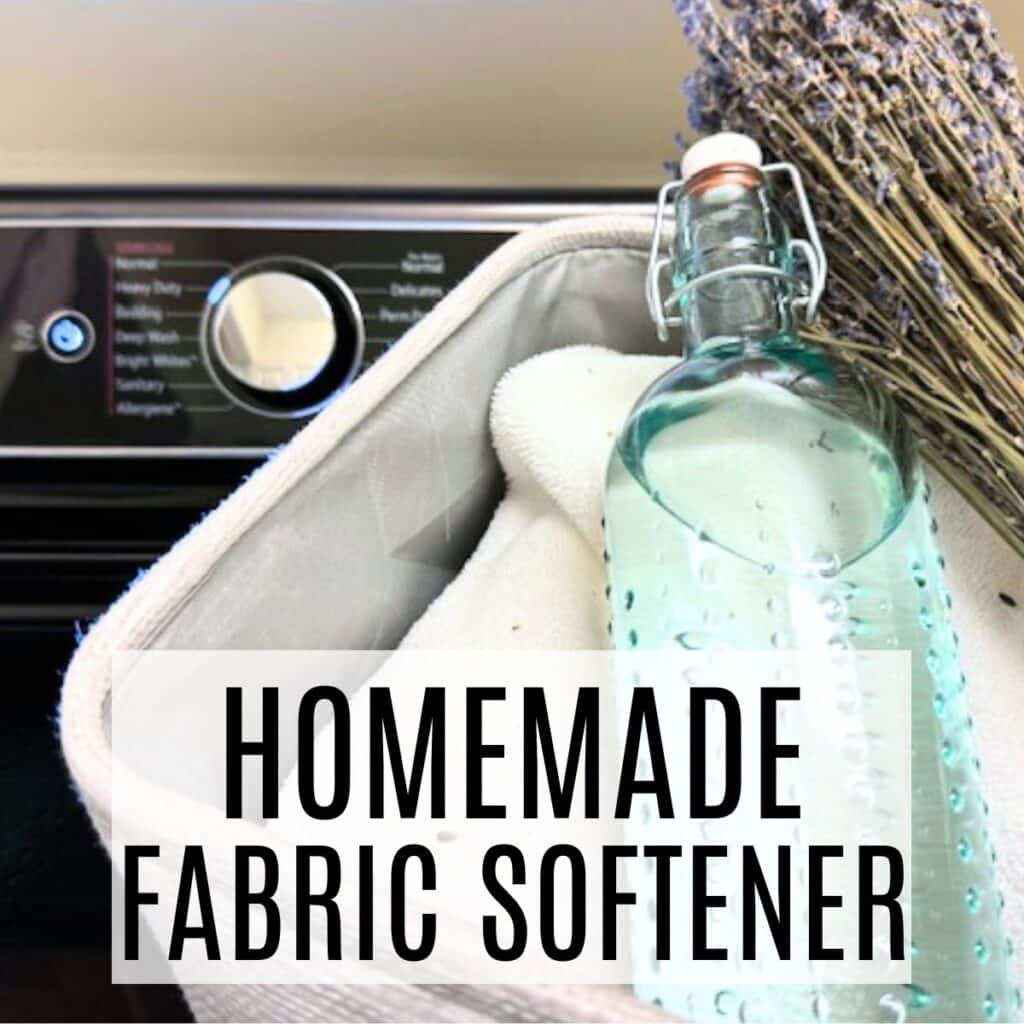
A few years ago, I started using a homemade fabric softener. It smelled great and looked just like the fabric softeners you buy in the store.
Although it worked well, it was full of ingredients I didn't even know how to pronounce. So I began my search for a more natural alternative.
I finally found a solution that I love. Plain old white distilled vinegar works great as a natural fabric softener.
The best part is that it's so inexpensive to make!
Because our clothes get bad static in the winter, I usually like to use a liquid fabric softener along with wool dryer balls. The dryer balls are a great alternative to dryer sheets and are budget-friendly.
I also use vinegar as a cleaning agent for the dishwasher, floors, and as a multi purpose cleaner.
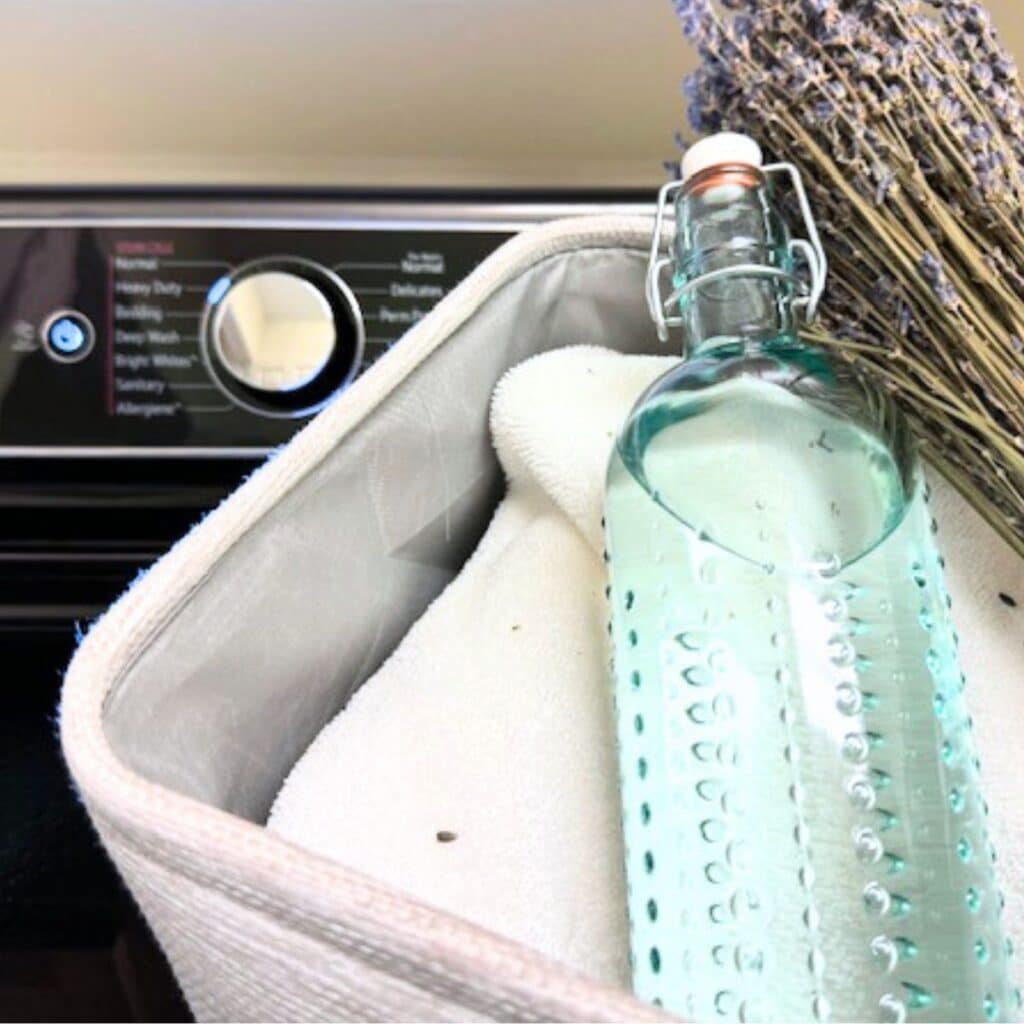
Why Use Liquid Softener Anyway?
- Soften Fabric: Fabric softeners work by coating the fibers of clothes with a thin layer of chemicals that have a lubricating effect. This helps to reduce the friction between the fibers, making the fabric feel softer and smoother to the touch. There is a noticeable difference with fabrics like towels, sheets, and clothing items that might otherwise feel stiff after washing.
- Reduce Static Cling: Fabric softeners also help to reduce static electricity buildup in clothes, which is great for synthetic fabrics.
- Minimize Wrinkles: The lubricating effect of fabric softeners can also act as a wrinkle reducer. The softer fibers are less likely to crease and fold tightly.
- Fresh Scent: Laundry softener often has a light scent which we love! This helps to mask any lingering odors from washing, and once garments are dried, our laundry smells fresh and clean.
- Aid in Ironing: Softened fabrics are generally easier to iron, as the iron tends to glide smoothly over clothes.
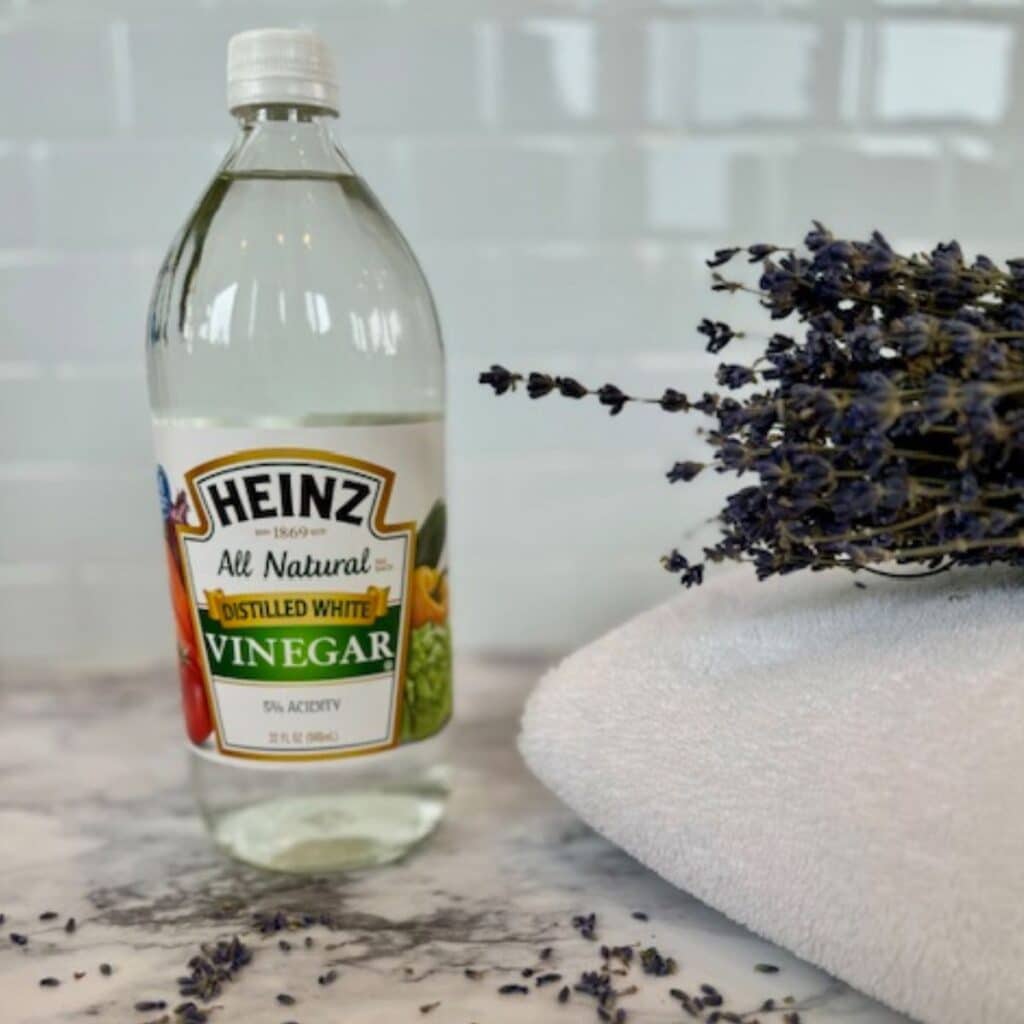
I Heard Vinegar Isn't Good For the Washing Machine!
Some sources will report that using too much vinegar will lead to deteriorating hoses and cause leaks, especially for front-loading washers (aka high-efficiency washers).
I personally use this mixture all of the time and have never had any issues. It's also worth noting that the laundry expert claims this is due to the acidity of vinegar. On the scale, its pH level is about 2.4. However, traditional fabric softener (such as Downy) is around a 3.0 depending on what scent you look up.
There's not a ton of difference, so I will take my chances. I would much rather use vinegar and avoid fewer chemicals versus continuous exposure to conventional fabric softeners.

Free Weekly Cleaning Printable
Clean your home in under 30 minutes a day with this free Weekly Cleaning printable!
Does White Vinegar Work as Good as Commercial Fabric Softeners?
Vinegar softens clothes and fabric fibers by removing any soap buildup and removes any of the mineral deposits in hard water. Because of this, it will leave your clothes feeling soft and fluffy like you used the store-bought fabric softeners and doesn't leave a vinegar smell.
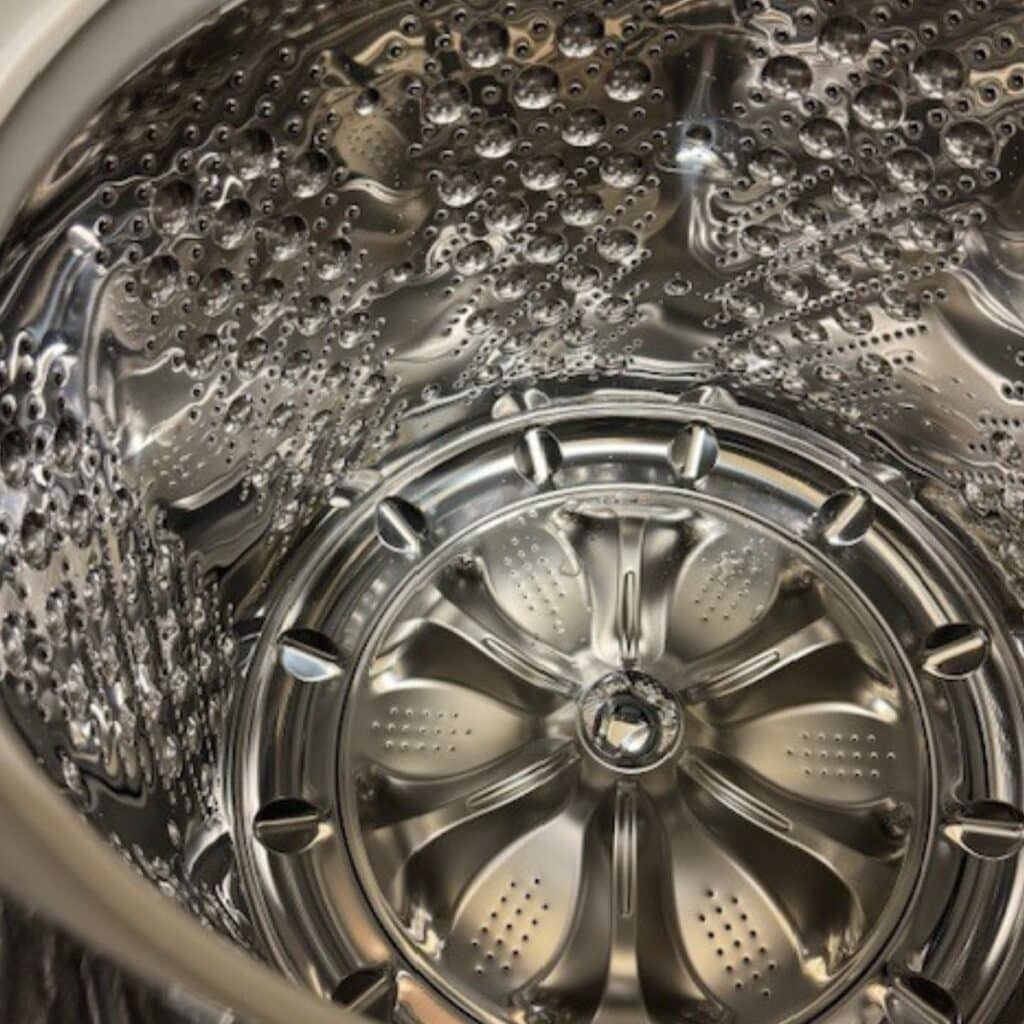
Other Benefits of Using Vinegar in Laundry
Mildew Odor - While you are softening your clothes, the vinegar helps to remove those nasty smells. The gasket around the front loader door traps moisture and detergent residue, often leaving washing machines smelling awful.
Stain Remover - combine undiluted distilled white vinegar with a tablespoon of Dawn dish detergent. Pretreat stains in the affected area 30 minutes before washing. To make a bigger batch, follow the same recipe and add to a spray bottle. Store in the laundry room.
Cleaning cycle - to deep clean your washer, make sure there are no garments in there. Add 2 cups of vinegar to the fabric softener compartment. Run on a wash cycle with hot water. Once it has finished, wipe down the inner gasket. This process will help remove the soap residue, mildew, etc. If you have a top loader that doesn't have a compartment, dump the vinegar directly into the washer.

What You'll Need To Make 2 Ingredient DIY Vinegar Fabric Softener
- Glass bottle - I just picked up one on Amazon.
- Bottle of vinegar - Use white distilled vinegar only. Apple cider vinegar does not do the trick in this case! Distilled white vinegar doesn't contain natural plant dyes (tannins), so it will not stain.
- Essential oils - For this recipe, I used DoTerra Serenity with Lavender, but you can use your favorite.
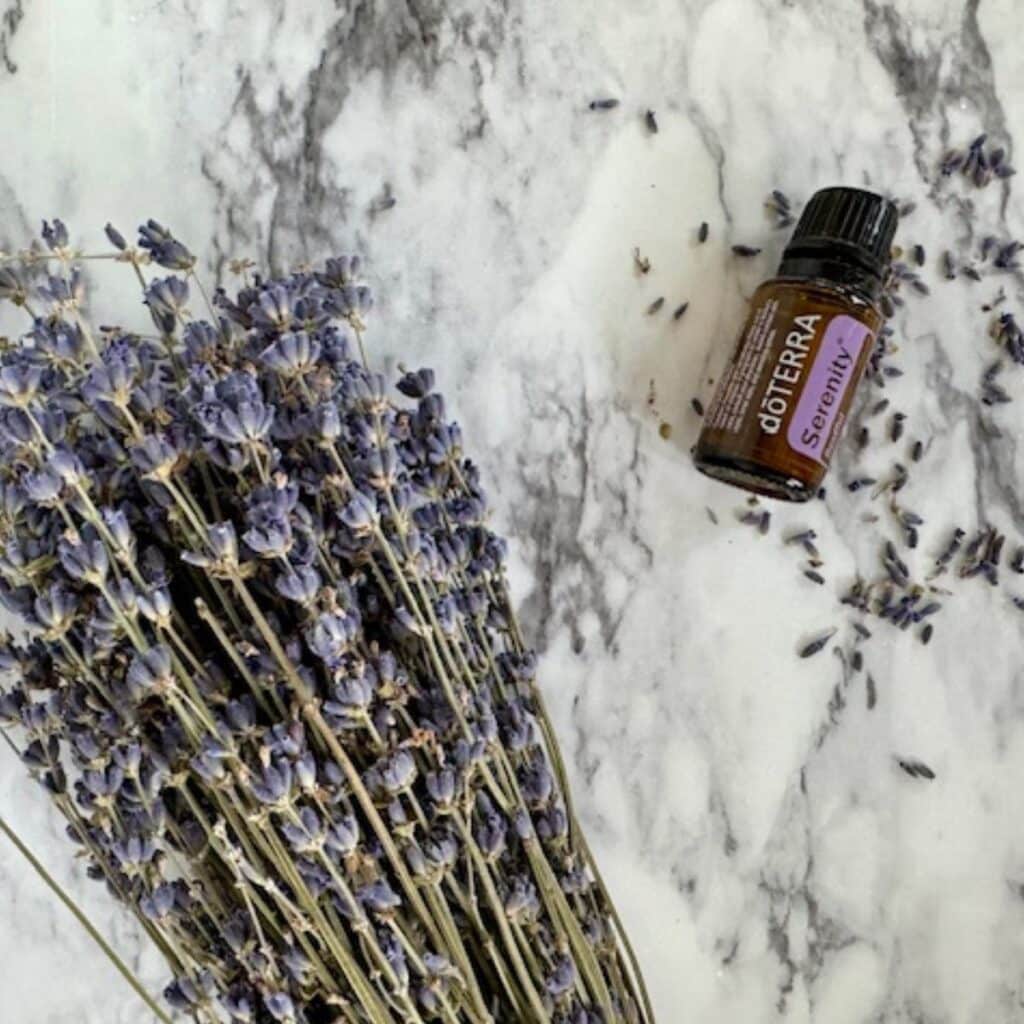
How to Make Vinegar Fabric Softener
Step 1: Measure out 4 cups of white vinegar and pour into a glass bottle.
Step 2: Add 10 drops of essential oil of your choice.
Step 3: Shake well, and start using!
To use vinegar fabric softener: Add 1/4 cup to 1/2 cup to the fabric softener compartment at the beginning of the wash cycle for each load.
If you don't have a compartment, add the mixture to a fabric softener dispenser.
Best Practices:
- Avoid adding the softener to the wrong compartment.
- Never mix vinegar with chlorine bleach. The chemical reaction creates a toxic chlorine gas that is harmful to breathe.
- For garments that contain elastic, you may want to use a regular fabric softener or a reduced amount of vinegar softener. Over time, the acetic acid can break down the fibers.
- Do not mix with hydrogen peroxide, this creates a corrosive substance.
- Undiluted vinegar could possibly bleach dark-colored clothes.
Common FAQs
We do not recommend using baking soda in conjunction with or to take the place of fabric softener. Baking soda will simply cancel out the benefits that the vinegar offers.
Yes, diluted vinegar is generally safe to use on most fabrics with the exception of those that have a lot of elastic. However, it's always recommended to do a patch test on a small, inconspicuous area of the fabric to ensure there are no adverse effects.
A common ratio is about 1/4 to 1/2 cup of vinegar per load of laundry. Adjust the amount based on the size of your load .
Yes, vinegar fabric softener can be used on wet towels to help maintain their softness and absorbency. Plus, it will remove that old, mildewy smell that often lingers after drying.
In conclusion, using DIY vinegar fabric softener with essential oils is an affordable option, readily accessible, and a great way to start replacing chemical-containing cleaning products.



Katie says
Hi. I tried out the recipe and didn't notice a lavender smell on my sheets after they were dried. I wonder if the vinegar cancelled out the smell of the oils. I even used the brand you suggested. Any ideas?
Julie says
You can always try adding more essential oils in the vinegar if you want a stronger smell. I hope that helps.
Sharon says
I was a little confused by you saying you purchased the flip top bottles and then you said to store it in a glass container. I looked up the flip top bottles and the biggest they had was 4 oz. So do you keep filling the flip top bottle, just doesn't seem to make sense to me.
Julie says
The bottle in the link should be 33 3/4 ounces, not 4 ounces. I hope that helps.
Julie says
We have a fragrance allergy in our house so we try to keep things fragrance-free. If I just used vinegar with no essential oils, would my clothes come out smelling like vinegar??
Julie says
You can use just vinegar and they should still come out smelling fresh and clean. Sometimes they smell like just a hint of vinegar before they dry but once the clothes dry I have never noticed it.
Julie says
Great, thanks! I'll give it a shot, especially now that winter is coming and clothes are feeling stiffer.
Jen B says
I just tried this idea with a load of towels, but I didn't add the essential oil because I was too lazy to dig it out. (I don't like to use regular fabric softener with towels because it can make them less absorbent.) Worked great! I will do this again and try it with the oil next time. Thanks!
Julie says
You are welcome!
Jhc says
So many of these recipes for home made products suggest purchasing containers. Why not just reuse and relabel empty spray bottles, plastic jugs, etc that you would normally recycle??
Julie says
I always like to recommend a new bottle because I never know what would have been in other peoples old bottles. In this case, vinegar can react with bleach or hydrogen peroxide and cause gases or chemical burns. As long as you are careful with what bottles you are putting them in then go for reusing or recycling your containers.
Tonya Thrash says
Does it need to be stored in a glass bottle?
Julie says
Hi Tonya, no it doesn't need to be stored in a glass bottle but I would be careful what kind of container you are using. If you are reusing an old container make sure that bleach or hydrogen peroxide wasn't previously stored in it. Vinegar can react with either bleach or hydrogen peroxide causing bad gases or even chemical burns.